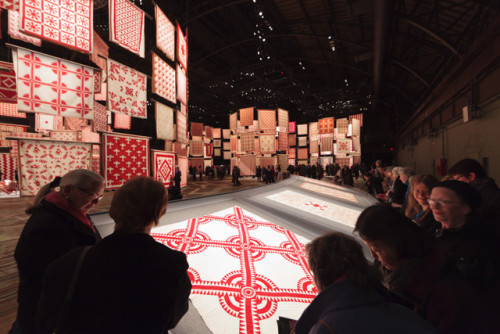
Infinite Variety: Three Centuries of Red and White Quilts
Thinc Design, New York, New York, 2011
Description
The American Folk Art Museum contacted Thinc Design in March 2010, inviting us to participate in a design competition amongst a small number of firms. The written brief was incredibly short—less than a page long. The museum asked for an installation design for 800 red and white quilts from a private collection. The exhibition would be held over the course of five days in March 2011, and it would be the largest quilt display devoted to a single color scheme ever presented. The location would be the 55,000-square-foot Drill Hall of the Park Avenue Armory, an 85-foot-high vaulted structure with distinct historic character. The brief included the necessity for an integrated museum shop and café area, and the entire exhibition needed to be able to be installable in less than three days.
Through conversations with the curator, we learned that this was the first large quilt event in New York City in nearly a decade, and, unlike previous events, it would be free to the public. We also discovered that the installation would have a minimal amount of didactic information. The collector wanted the quilts to appear as a united vision: a spectacular overall view that included nearly endless, explorable variation. The experience also needed to be true to quilters’ passions and fully engaging to a larger audience.
We were challenged to show the collection as a collection, in addition to successfully exhibiting the individual quilts, without overwhelming the public. The quantity of quilts was one of the show’s defining characteristics; the patterning array and the material volume were breathtaking. However, visitors also needed to experience the quilts without a feeling of relentless repetition—particularly those who were not already passionate about quilts.
We were informed that we would be responsible for all aspects of the display and installation, and the design needed to be “efficient and cost-effective.” We were initially told that we would work with a graphic designer of the museum’s choice; we instead proposed to provide that service ourselves.
Throughout the course of the design execution it was determined that 651 quilts would be exhibited. The installation time was reduced to less than 72 hours so that the exhibit could remain open for an additional day. Though the museum considered the primary target audience to be quilters, and the sold-out adjacent programming supported this notion, the collector, Joanna S. Rose, considered this installation a “gift to New York.” Due to the influence of a strong collaboration with the public relations firm Resnicow Schroeder and a growing audience attending arts programming at the Armory, the installation was highly anticipated by the design, architecture, arts and quilting communities.
Our graphic design scope expanded from the creation of street banners, a brochure and a single didactic platform to include advertisements for both antique shows and the New York Times. We also provided signage for the call-in cell phone tour (which included perspectives from both the curators and our designers on the creation of the exhibition) and graphics for an iPhone/iPad app that allowed visitors to look at each of the 651 quilts in greater detail. From the initial brief, throughout the design process, we understood that this exhibition needed to be awe-inspiring in all respects—from its vast, overall impression and scale, down to the ability to view each quilt’s individual details.
Read the full case study with juror comments here: [http://www.aiga.org/justified-2012--case-study--infinite-variety/]
Credits
- Design firm
- Thinc Design
- Client
- American Folk Art Museum




